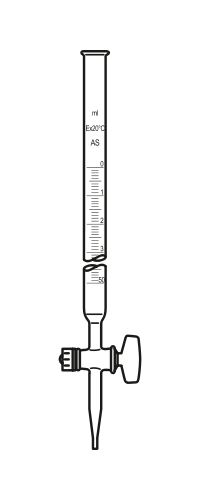Burette

A burette (also buret) is a device used in analytical chemistry for the dispensing of variable, measured amounts of a chemical solution. A volumetric burette delivers measured volumes of liquid. Piston burettes are similar to syringes, but with precision bore and plunger. Piston burettes may be manually operated or may be motorized.[1] A weight burette delivers measured weights of liquid.[2]
Uses
- In analytical chemistry, for the supplying of variable, measured amounts of chemical solution.
- A weight burette for measuring weights of liquid.
Overview
A burette is distinguished from a pipette by the fact that the quantity delivered is variable. Thus in a titration, one solution is dispensed with a pipette, and another solution is added to it from a burette in aliquots of varying size.
Burettes may be designated for use at a particular temperature. If used at another temperature they should be subject to calibration.
Volumetric burettes
Analogue
A traditional burette consists of glass tube of constant bore with a graduation scale etched on it and a stopcock at the bottom. The barrel of the stopcock may be made of glass or the plastic PTFE. Stopcocks with glass barrels need to be lubricated with vaseline or a specialized grease. Burettes are manufactured to specified tolerances, designated as class A or B and this also is etched on the glass.[3]
Burette accuracy /mL Capacity, mL Class A Class B 10 0.02 0.04 25 0.03 0.06 50 0.05 0.10 100 0.10 0.20
Digital

Digital burettes are based on a syringe design. The barrel and plunger may be made of glass. With liquids that corrode glass, including solutions of alkali, the barrel and plunger may be made of polyethylene or another resistant plastic material. The barrel is held in a fixed position and the plunger is moved incrementally either by turning a ratcheted wheel by hand, or by means of a step-motor. The volume is shown on a digital display. A high-precision syringe may be used to deliver very precise aliquots. Motorized digital burettes may be controlled by computer; for example, a titration may be recorded digitally and then subject to numerical processing to find the titre at an end-point.
Gallery
References
- ↑ Mendham, J.; Denney, R. C.; Barnes, J. D.; Thomas, M. J. K. (2000), Vogel's Quantitative Chemical Analysis (6th ed.), New York: Prentice Hall, ISBN 0-582-22628-7 Section 3.12, p.79, "Burettes"
- ↑ Redman, H. N. (1963). "An improved type of weight burette for use in volumetric analysis". Analyst. 88: 654–655. doi:10.1039/AN9638800654.
- ↑ Pradyot Patnaik (2003). "Specifications for volumetric ware". Dean's Handbook of Analytical Chemistry, 2nd Edition. McGraw-Hill. ISBN 978-0071410601.
External links
- Using a Burette from ChemLab at Dartmouth College demonstrating how to use a burette correctly
- Use of the Buret

